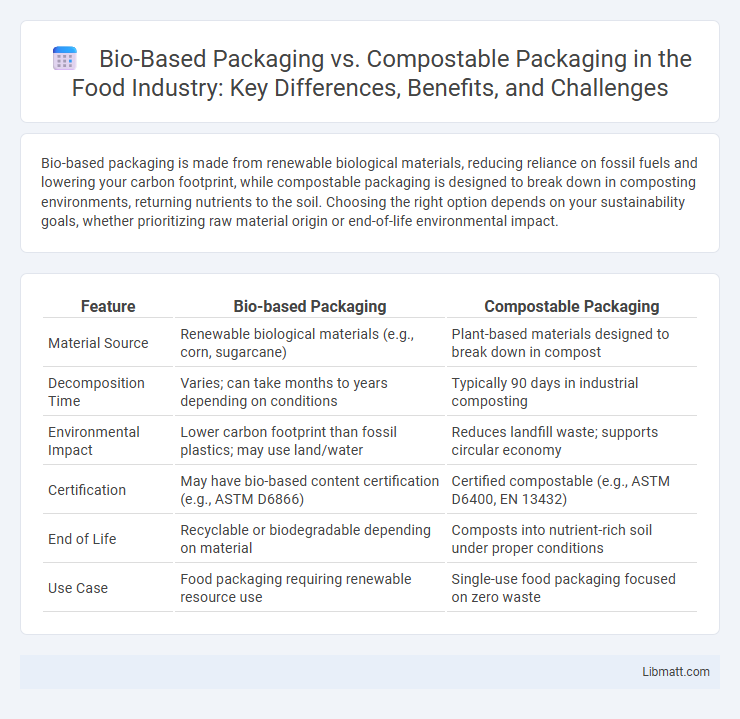Bio-based packaging is made from renewable biological materials, reducing reliance on fossil fuels and lowering your carbon footprint, while compostable packaging is designed to break down in composting environments, returning nutrients to the soil. Choosing the right option depends on your sustainability goals, whether prioritizing raw material origin or end-of-life environmental impact.
Table of Comparison
| Feature | Bio-based Packaging | Compostable Packaging |
|---|---|---|
| Material Source | Renewable biological materials (e.g., corn, sugarcane) | Plant-based materials designed to break down in compost |
| Decomposition Time | Varies; can take months to years depending on conditions | Typically 90 days in industrial composting |
| Environmental Impact | Lower carbon footprint than fossil plastics; may use land/water | Reduces landfill waste; supports circular economy |
| Certification | May have bio-based content certification (e.g., ASTM D6866) | Certified compostable (e.g., ASTM D6400, EN 13432) |
| End of Life | Recyclable or biodegradable depending on material | Composts into nutrient-rich soil under proper conditions |
| Use Case | Food packaging requiring renewable resource use | Single-use food packaging focused on zero waste |
Introduction to Eco-Friendly Packaging Solutions
Bio-based packaging is derived from renewable biological sources such as plants and agricultural waste, offering a sustainable alternative to traditional plastics. Compostable packaging is designed to break down into natural elements within a specific timeframe under composting conditions, reducing landfill waste and environmental impact. Understanding these eco-friendly packaging solutions helps you make informed choices that support sustainability and reduce plastic pollution.
Defining Bio-Based Packaging
Bio-based packaging is produced from renewable biological sources such as plants, crops, or algae, reducing reliance on fossil fuels and minimizing carbon footprint. It differs from compostable packaging, which specifically refers to materials designed to break down in composting environments, whereas bio-based packaging may not always be compostable. Key materials for bio-based packaging include polylactic acid (PLA), starch blends, and cellulose, offering sustainable alternatives to traditional plastics while maintaining functionality.
Understanding Compostable Packaging
Compostable packaging is designed to break down into natural elements within a specific timeframe under industrial or home composting conditions, minimizing environmental impact. This type of packaging is certified to meet standards such as ASTM D6400 or EN 13432, ensuring it decomposes safely without leaving harmful residues. Understanding these certifications can help you choose truly sustainable packaging solutions that support waste reduction and circular economy goals.
Key Material Differences: Bio-Based vs Compostable
Bio-based packaging is derived from renewable biological sources such as plants, sugars, and starches, emphasizing raw material origin rather than disposal method. Compostable packaging specifically refers to products designed to break down into non-toxic components under composting conditions, meeting certifications like ASTM D6400 or EN 13432. Your choice between bio-based and compostable packaging should consider both the material's source and its end-of-life impact for sustainable packaging solutions.
Environmental Impact Comparison
Bio-based packaging is derived from renewable biological sources such as corn, sugarcane, or cellulose, reducing reliance on fossil fuels and lowering carbon footprints during production. Compostable packaging, made from bio-based materials designed to break down in industrial composting environments, minimizes landfill waste and reduces methane emissions associated with organic waste decomposition. While both options improve environmental outcomes, compostable packaging offers added benefits by enhancing waste management efficiency and facilitating nutrient recycling through degradation into organic matter.
Performance and Durability Analysis
Bio-based packaging, derived from renewable biological materials, often offers enhanced durability and resistance to moisture and mechanical stress compared to compostable packaging, which is designed to break down efficiently in industrial composting environments. Compostable packaging excels in environmental sustainability by decomposing rapidly under specific conditions but may have limitations in performance and shelf life due to its biodegradable nature. You should consider the intended use of the packaging, as bio-based options provide robust protection for longer-term applications while compostable materials are ideal for short-term, eco-friendly disposal.
End-of-Life Disposal and Decomposition
Bio-based packaging is made from renewable biological sources but may not always be compostable or biodegradable, requiring specific disposal methods to avoid environmental harm. Compostable packaging is designed to break down into nutrient-rich compost under industrial or home composting conditions within a defined timeframe, supporting soil health and reducing landfill waste. Understanding the differences in end-of-life disposal ensures your packaging choices align with sustainability goals and waste management systems.
Regulatory Standards and Certifications
Bio-based packaging is primarily evaluated by standards such as ASTM D6866, which measures the biobased carbon content, ensuring materials originate from renewable sources. Compostable packaging must comply with certifications like the ASTM D6400 or EN 13432, which verify that products biodegrade under industrial composting conditions within a specific timeframe without leaving toxic residues. Regulatory frameworks, including the European Union's Packaging and Packaging Waste Directive and the U.S. Federal Trade Commission's Green Guides, dictate labeling and environmental claims to prevent misleading consumers regarding biodegradability and compostability.
Market Trends and Consumer Preferences
Bio-based packaging, derived from renewable biological sources such as cornstarch and sugarcane, is experiencing rapid growth due to increasing consumer demand for sustainable alternatives to fossil-fuel plastics. Compostable packaging, designed to break down in industrial or home composting systems, appeals to eco-conscious consumers prioritizing end-of-life environmental impact and circular economy principles. Market trends indicate a strong preference for transparent labeling and certifications, with brands leveraging bio-based and compostable claims to capture the expanding green packaging segment valued at over $10 billion globally.
Choosing the Right Packaging for Your Needs
Bio-based packaging, derived from renewable biological sources like corn or sugarcane, offers a sustainable alternative with lower carbon footprints but may not always be compostable under home conditions. Compostable packaging, certified to break down in industrial composting facilities within a specific timeframe, ensures waste returns to the soil without harmful residues, ideal for businesses targeting zero waste goals. Selecting the right packaging depends on product lifecycle, disposal infrastructure, and environmental impact priorities, with emphasis on certifications like ASTM D6400 or EN 13432 for compostability assurance.
Bio-based Packaging vs Compostable Packaging Infographic

 libmatt.com
libmatt.com